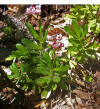|
Chimaphila umbellata |
Chimaphila umbellata Oregon—Cascade Region. Big Meadows Road, east off Hwy 22, ~ 4 miles north of junction with Hwy 22, Mt Jefferson Region; 44º32'58.2", 121º58’55.7”, 1125 m. Douglas fir forest with dense understory of Xerophyllum. SPJ-16427, 15 Aug 2008
|
|
Trees and Shrubs of Kern County (Sep 2012) Chimaphila menziesii (Pyrola menziesii R. Br ex D. Don 1824) Sprengel 1825. Little prince's pine. A short, single woody-stemmed plant with relatively large leathery leaves spirally clustered near the apex, which may be exceeded by 1-several flowering or fruiting stems; flowering Jun–Aug. A common understory shrublet of the northern montane forests, British Columbia east to Idaho, less common in California, south to San Diego Co., 2,500–8,000 ft. Type from northwest Coast of America. Kern Co.: Rare, reported by Moe from a single collection by Twisselmann from the Greenhorn Range near Tiger Flat. References on Pharmacological Activity in Chimaphila Galván I.J., N. Mir-Rashed, M. Jessulat, M. Atanya, A. Golshani, T. Durst, P. Petit, V. T. Amiguet, T. Boekhout, R. Summerbell, I. Cruz, J. T. Arnason and M. L. Smith. 2007. Antifungal and antioxidant activities of the phytomedicine Pipsissewa, Chimaphila umbellata. Phytochemistry. Oct . “Bioassay-guided fractionation of Chimaphila umbellata (L.) W. Bart (Pyrolaceae) ethanol extracts led to the identification of 2,7-dimethyl-1,4-naphthoquinone (chimaphilin) as the principal antifungal component. The structure of chimaphilin was confirmed by (1)H and (13)C NMR spectroscopy. The antifungal activity of chimaphilin was evaluated using the microdilution method with Saccharomyces cerevisiae (0.05mg/mL) and the dandruff-associated fungi Malassezia globosa (0.39mg/mL) and Malassezia restricta (0.55mg/mL). Pronounced antioxidant activity of C. umbellata crude extract was also identified using the DPPH (2,2-diphenyl-1-picrylhydrazyl) assay, suggesting this phytomedicine has an antioxidant function in wound healing. A chemical-genetic profile was completed with chimaphilin using approximately 4700 S. cerevisiae gene deletion mutants. Cellular roles of deleted genes in the most susceptible mutants and secondary assays indicate that the targets for chimaphilin include pathways involved in cell wall biogenesis and transcription.” Oka M., M. Tachibana, K. Noda, N. Inoue, M. Tanaka and K. Kuwabara. 2007. Relevance of anti-reactive oxygen species activity to anti-inflammatory activity of components of eviprostat, a phytotherapeutic agent for benign prostatic hyperplasia. Phytomedicine 14(7-8): 465–472. “Inflammation is a common finding in benign prostatic hyperplasia (BPH). The phytotherapeutic agent eviprostat is a popular treatment for BPH in Japan and Germany. This agent consists of five components; four are extracted from Chimaphila umbellata, Populus tremula, Pulsatilla pratensis and Equisetum arvense (coded as EVI-1, EVI-2, EVI-3 and EVI-4, respectively) and the fifth is germ oil from Triticum aestivum (coded as EVI-5). In this study, the effects of each component on the reactive oxygen species (ROS), superoxide anion (O2-) and hydroxyl radical (OH*) generated in cell-free systems and human neutrophils, and on carrageenin-induced paw edema in rats were investigated. EVI-1, EVI-2 and EVI-4 suppressed the O2- levels in the xanthine/xanthine oxidase system, and EVI-1, EVI-2, EVI-3 and EVI-4 abolished the OH* produced in a Fenton-type reaction system, so that EVI-1, EVI-2 and EVI-4 possessed inhibitory action with respect to both O2- and OH*. EVI-1, EVI-2 and EVI-4 also reduced ROS levels in phorbol myristate acetate-stimulated neutrophils. The paw swelling was inhibited by a mixture of EVI-1, EVI-2, EVI-3, EVI-4 and EVI-5 (a mixture which is equivalent to eviprostat) or by a mixture of EVI-1, EVI-2 and EVI-4, even though each component alone did not significantly inhibit the swelling. These findings suggest that the suppression of ROS by EVI-1, EVI-2 and EVI-4 may partly contribute to the anti-inflammatory action of eviprostat, and this action may be implicated in its therapeutic effect on BPH.” |
|

